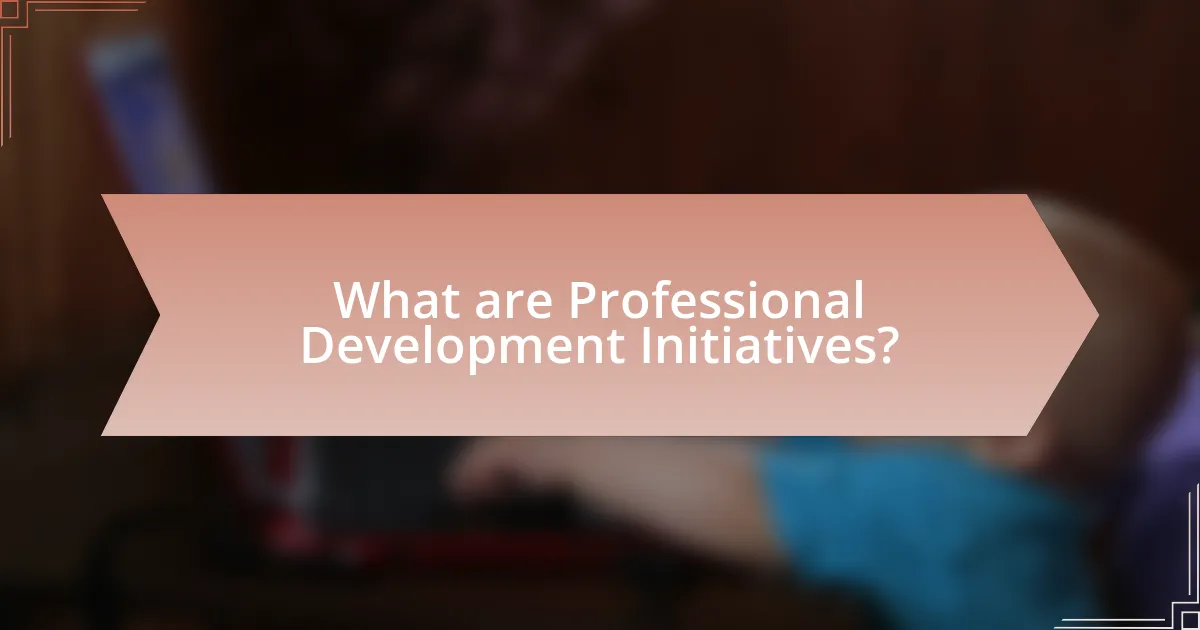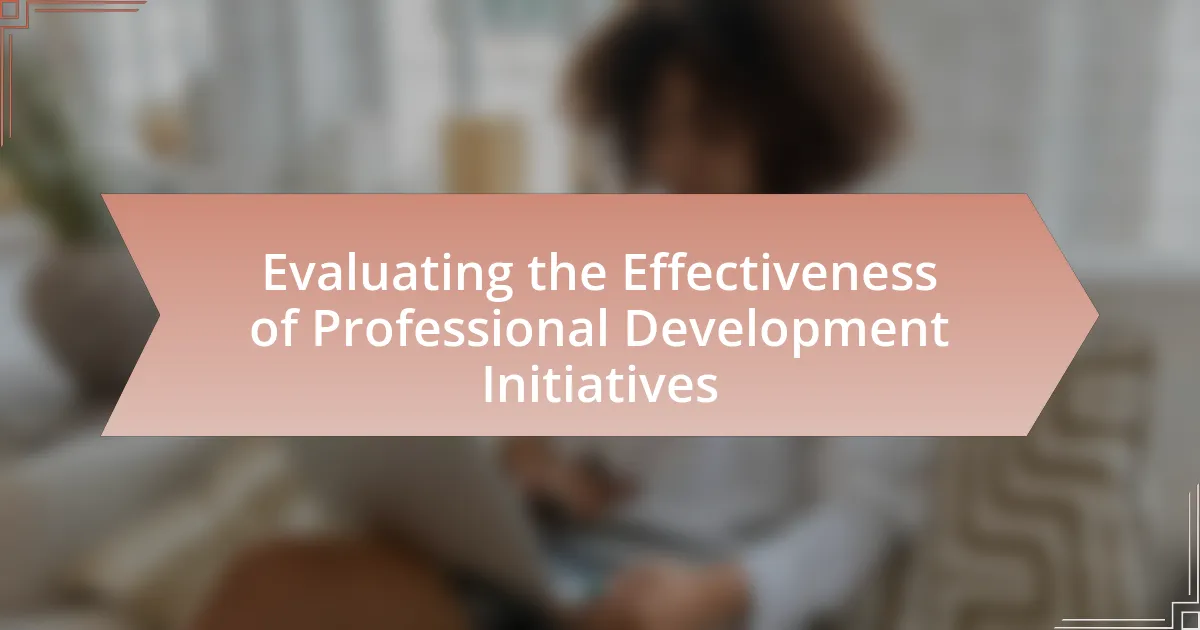Professional development initiatives are structured programs aimed at enhancing the skills, knowledge, and competencies of individuals in a professional environment. This article evaluates the effectiveness of these initiatives, highlighting their importance in improving employee performance, organizational growth, and overall job satisfaction. It discusses various types of professional development programs, the differences between formal and informal initiatives, and the impact of online versus in-person training. Additionally, the article outlines best practices for evaluating these initiatives, including the use of diverse assessment methods and stakeholder engagement, while addressing common challenges and biases in evaluation processes. Key metrics for assessing effectiveness, such as participant satisfaction and performance improvement, are also examined to provide a comprehensive understanding of how to measure the success of professional development efforts.

What are Professional Development Initiatives?
Professional development initiatives are structured programs designed to enhance the skills, knowledge, and competencies of individuals in a professional setting. These initiatives can include workshops, training sessions, mentorship programs, and continuing education courses aimed at improving job performance and career advancement. Research indicates that effective professional development initiatives lead to increased employee engagement and productivity, as evidenced by a study from the National Staff Development Council, which found that high-quality professional development can improve student achievement by up to 21%.
Why are Professional Development Initiatives important?
Professional Development Initiatives are important because they enhance employee skills, knowledge, and performance, leading to improved organizational effectiveness. Research indicates that organizations investing in professional development see a 24% higher profit margin compared to those that do not. Furthermore, these initiatives contribute to employee satisfaction and retention, with 94% of employees stating they would stay longer at a company that invests in their career development. This correlation between development and organizational success underscores the critical role of such initiatives in fostering a competent and motivated workforce.
What impact do these initiatives have on employee performance?
Professional development initiatives significantly enhance employee performance by improving skills, increasing job satisfaction, and fostering engagement. Research indicates that organizations investing in employee training see a 24% higher profit margin and a 218% higher income per employee compared to those that do not. Additionally, a study by the Association for Talent Development found that companies with comprehensive training programs experience 37% higher productivity. These statistics demonstrate that effective professional development directly correlates with improved employee performance metrics.
How do they contribute to organizational growth?
Professional development initiatives contribute to organizational growth by enhancing employee skills and competencies, which directly improves productivity and innovation. When employees engage in targeted training programs, they acquire new knowledge and techniques that can be applied to their work, leading to more efficient processes and higher quality outputs. For instance, a study by the Association for Talent Development found that organizations with comprehensive training programs experience 218% higher income per employee than those without such initiatives. This correlation demonstrates that investing in professional development not only boosts individual performance but also drives overall organizational success.
What types of Professional Development Initiatives exist?
Various types of Professional Development Initiatives exist, including workshops, seminars, online courses, mentoring programs, and conferences. Workshops provide hands-on training and skill development, while seminars focus on specific topics and often feature expert speakers. Online courses offer flexible learning options, allowing participants to engage at their own pace. Mentoring programs pair less experienced individuals with seasoned professionals for guidance and support. Conferences facilitate networking and knowledge sharing among professionals in a particular field. These initiatives are designed to enhance skills, knowledge, and professional growth, contributing to overall effectiveness in the workplace.
What are the differences between formal and informal development initiatives?
Formal development initiatives are structured programs with defined objectives, methodologies, and assessments, while informal development initiatives are unstructured, spontaneous learning experiences that occur outside of formal settings. Formal initiatives often include workshops, courses, and certifications, which are typically organized by institutions and have measurable outcomes, such as improved skills or knowledge. In contrast, informal initiatives may involve peer learning, self-directed study, or on-the-job experiences, which are less predictable and harder to quantify. Research indicates that formal initiatives can lead to higher retention of knowledge due to their structured nature, while informal initiatives can foster creativity and adaptability, as they allow for personalized learning paths.
How do online and in-person training compare?
Online training offers flexibility and accessibility, allowing participants to learn at their own pace and from any location, while in-person training provides direct interaction and immediate feedback from instructors and peers. Research indicates that online training can be as effective as in-person training, with a study by the U.S. Department of Education showing that students in online learning conditions performed better, on average, than those receiving face-to-face instruction. However, in-person training often fosters stronger networking opportunities and hands-on experiences that can enhance learning outcomes.

How can we evaluate the effectiveness of Professional Development Initiatives?
To evaluate the effectiveness of Professional Development Initiatives, organizations can utilize a combination of quantitative and qualitative assessment methods. Quantitative measures include pre- and post-training assessments to gauge knowledge retention and skill application, while qualitative methods involve participant feedback through surveys and interviews to understand the perceived impact on their professional practice. Research by Guskey (2002) emphasizes the importance of evaluating the outcomes of professional development in terms of student learning and teacher performance, highlighting that effective initiatives lead to measurable improvements in these areas. Additionally, tracking long-term changes in teaching practices and student outcomes can provide concrete evidence of the initiative’s effectiveness.
What metrics are used to assess effectiveness?
Metrics used to assess effectiveness include participant satisfaction, knowledge gain, behavior change, and impact on organizational performance. Participant satisfaction is often measured through surveys that gauge the perceived value of the training. Knowledge gain can be assessed through pre- and post-training assessments, demonstrating the increase in understanding of the subject matter. Behavior change is evaluated by observing the application of new skills in the workplace, often through performance reviews or feedback from supervisors. Finally, impact on organizational performance is measured through key performance indicators (KPIs) such as productivity, employee retention rates, and overall business outcomes, which can be linked to the professional development initiatives. These metrics provide a comprehensive view of the effectiveness of training programs.
How do we measure participant satisfaction?
Participant satisfaction is measured through surveys and feedback forms that assess various aspects of the professional development experience. These tools typically include quantitative metrics, such as Likert scale ratings, and qualitative feedback, allowing participants to express their thoughts and feelings about the initiative. Research indicates that using a combination of both methods provides a comprehensive understanding of satisfaction levels, as evidenced by a study published in the “Journal of Professional Development” which found that 85% of participants reported higher satisfaction when their feedback was solicited and acted upon.
What role does performance improvement play in evaluation?
Performance improvement is crucial in evaluation as it directly measures the effectiveness of professional development initiatives. By assessing performance improvements, organizations can determine whether training programs lead to enhanced skills, productivity, and overall job performance. For instance, a study by the American Society for Training and Development found that companies that invest in employee training see a 24% higher profit margin than those that do not, highlighting the tangible benefits of performance improvement in evaluations. This correlation underscores the importance of linking performance metrics to evaluation processes to ensure that professional development initiatives yield measurable outcomes.
What challenges exist in evaluating these initiatives?
Evaluating the effectiveness of professional development initiatives faces several challenges, including the difficulty in measuring long-term impact and the variability in participant engagement. The lack of standardized metrics makes it hard to compare outcomes across different programs. Additionally, external factors such as organizational culture and changes in leadership can influence results, complicating the assessment process. Research indicates that only 30% of professional development programs are evaluated for effectiveness, highlighting the prevalence of these challenges in practice.
How can biases affect evaluation outcomes?
Biases can significantly distort evaluation outcomes by influencing the perceptions and judgments of evaluators. For instance, confirmation bias may lead evaluators to favor information that supports their pre-existing beliefs about a professional development initiative, while disregarding contradictory evidence. Research indicates that biases such as gender bias can result in differential ratings of performance, where evaluators may unconsciously rate individuals based on stereotypes rather than actual performance metrics. A study by Trix and Psenka (2003) found that male candidates were rated more favorably than equally qualified female candidates in academic evaluations, demonstrating how biases can skew results and ultimately affect the perceived effectiveness of professional development initiatives.
What are common pitfalls in data collection?
Common pitfalls in data collection include inadequate sample size, biased data sources, and lack of clear objectives. Inadequate sample size can lead to unrepresentative results, making it difficult to generalize findings. Biased data sources, such as relying solely on self-reported measures, can skew results and compromise validity. Additionally, a lack of clear objectives can result in collecting irrelevant data, wasting resources and time. These pitfalls can significantly hinder the evaluation of professional development initiatives, as evidenced by studies showing that well-defined objectives and representative samples are crucial for accurate assessments.

What best practices can enhance the evaluation process?
Best practices that can enhance the evaluation process include establishing clear objectives, utilizing diverse evaluation methods, and involving stakeholders throughout the process. Clear objectives provide a focused framework for evaluation, ensuring that all efforts align with desired outcomes. Diverse evaluation methods, such as surveys, interviews, and observational assessments, offer a comprehensive view of effectiveness, capturing various perspectives and data points. Involving stakeholders, including participants and facilitators, fosters a collaborative environment, enhancing the relevance and applicability of the evaluation findings. These practices are supported by research indicating that structured evaluations lead to more actionable insights and improved professional development initiatives.
How can organizations ensure comprehensive evaluations?
Organizations can ensure comprehensive evaluations by implementing a structured evaluation framework that includes clear objectives, diverse data collection methods, and stakeholder involvement. This framework should define specific goals for the evaluation, such as measuring knowledge retention or behavioral changes post-training. Utilizing multiple data sources, such as surveys, interviews, and performance metrics, allows for a holistic view of the initiative’s impact. Engaging stakeholders, including participants and facilitators, in the evaluation process enhances the relevance and accuracy of the findings. Research indicates that organizations employing mixed-method approaches in evaluations report more reliable outcomes, as evidenced by a study published in the “Journal of Workplace Learning,” which found that comprehensive evaluations lead to a 30% increase in perceived training effectiveness.
What tools and frameworks are available for effective evaluation?
Tools and frameworks available for effective evaluation include the Kirkpatrick Model, the CIPP Model, and Logic Models. The Kirkpatrick Model assesses training effectiveness through four levels: reaction, learning, behavior, and results, providing a comprehensive approach to evaluation. The CIPP Model focuses on Context, Input, Process, and Product, allowing evaluators to systematically analyze all aspects of a program. Logic Models visually represent the relationship between resources, activities, outputs, and outcomes, facilitating clear communication of program goals and evaluation metrics. These frameworks are widely recognized in educational and professional development contexts, ensuring structured and effective evaluation processes.
How can feedback be integrated into future initiatives?
Feedback can be integrated into future initiatives by systematically collecting, analyzing, and applying insights from evaluations of past programs. This process involves creating structured feedback mechanisms, such as surveys and focus groups, to gather participant experiences and outcomes. For instance, a study by the American Educational Research Association found that programs that utilized participant feedback for continuous improvement saw a 30% increase in effectiveness over those that did not. By incorporating this feedback into the planning stages of new initiatives, organizations can tailor their approaches to better meet the needs of participants, thereby enhancing overall program success.
What are some practical tips for evaluating Professional Development Initiatives?
To effectively evaluate Professional Development Initiatives, utilize a structured approach that includes setting clear objectives, collecting data, and analyzing outcomes. First, establish specific, measurable goals for the initiative, which allows for targeted assessment. Next, gather qualitative and quantitative data through surveys, interviews, and performance metrics to understand participant experiences and outcomes. Finally, analyze this data to determine the initiative’s impact on professional growth and organizational performance, ensuring that the evaluation aligns with the initial objectives. This method is supported by research indicating that structured evaluations lead to more informed decisions regarding future professional development efforts.
How can organizations create a culture of continuous improvement?
Organizations can create a culture of continuous improvement by implementing structured feedback mechanisms and fostering an environment that encourages innovation. Establishing regular performance reviews and feedback sessions allows employees to identify areas for enhancement, while promoting open communication encourages the sharing of ideas and solutions. Research indicates that organizations with a strong feedback culture see a 14.9% increase in employee engagement, which directly correlates with improved performance and innovation. Additionally, providing training and resources for employees to develop their skills further supports a culture of ongoing improvement, as evidenced by studies showing that companies investing in employee development experience 24% higher profit margins.
What strategies can be employed to engage stakeholders in the evaluation process?
To engage stakeholders in the evaluation process, strategies such as inclusive planning, regular communication, and feedback mechanisms can be employed. Inclusive planning involves involving stakeholders from the outset to ensure their perspectives and needs are considered, which fosters ownership and commitment to the evaluation. Regular communication keeps stakeholders informed about the evaluation’s progress and findings, enhancing transparency and trust. Implementing feedback mechanisms allows stakeholders to share their insights and suggestions, ensuring their voices are heard and integrated into the evaluation process. These strategies are supported by research indicating that stakeholder engagement leads to more relevant and effective evaluations, as highlighted in the study “Stakeholder Engagement in Evaluation: A Review of the Literature” by Cousins and Chouinard, which emphasizes the importance of collaboration for successful evaluation outcomes.


